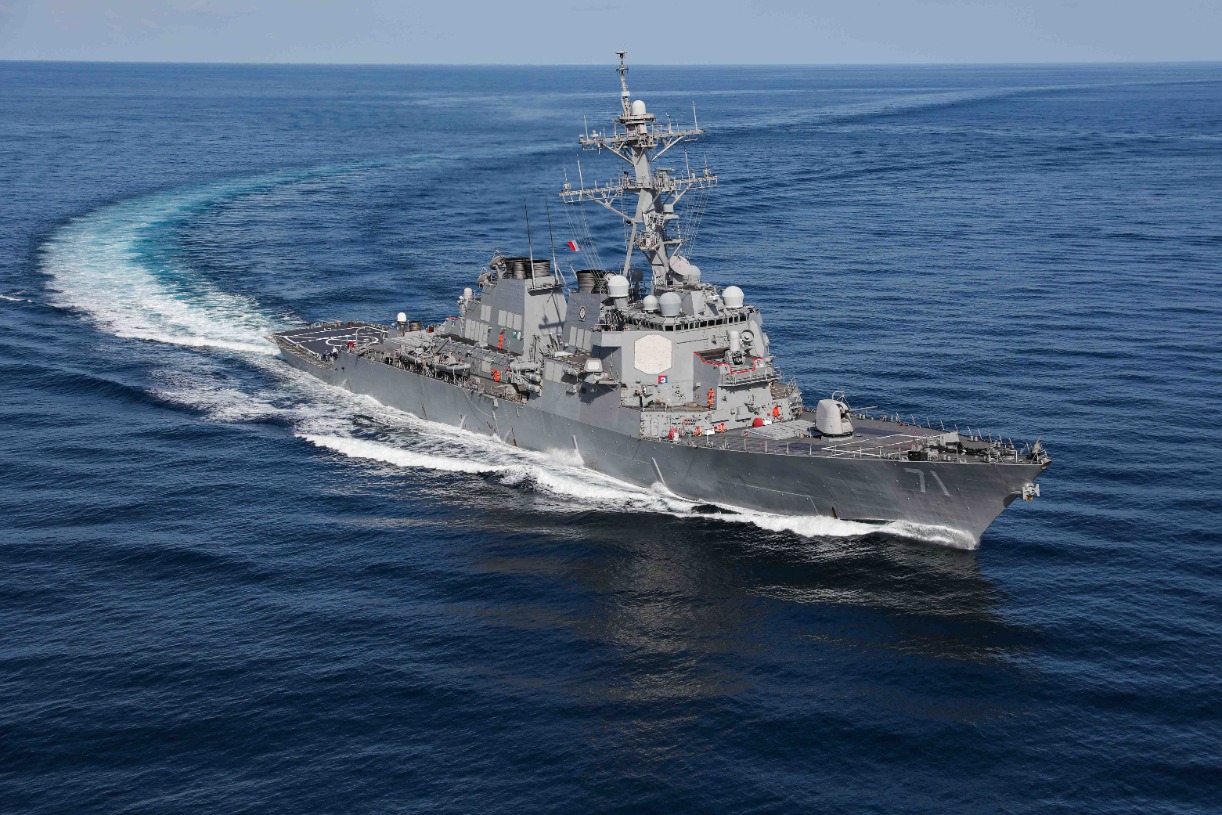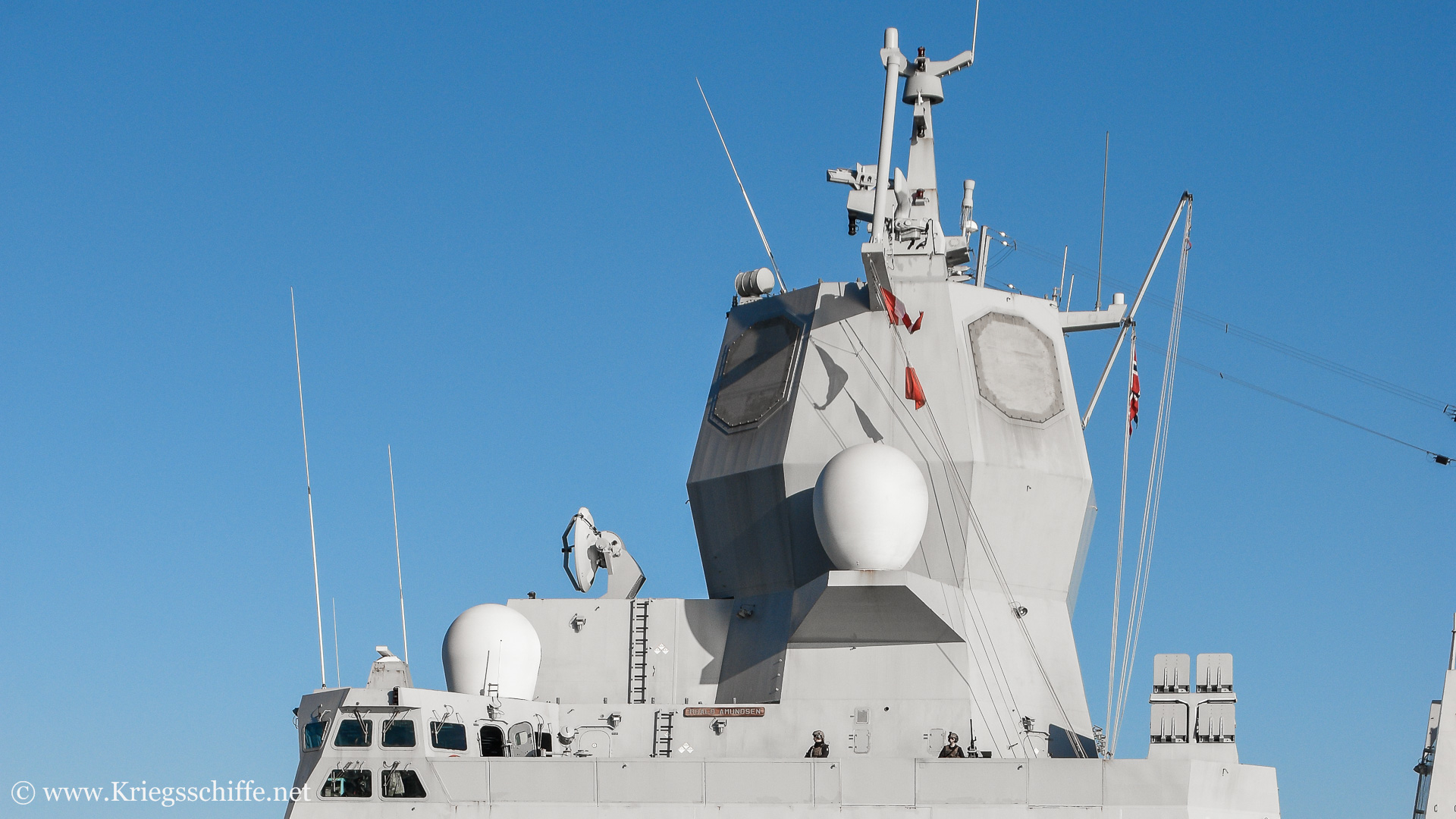Spy One Radar - The AN/SPI-1 radar antenna is a light gray octagonal plate located on the forward and starboard sides of the USS Lake Erie's superstructure.
Is a U.S. Navy 3D radar system manufactured by Lockheed Martin. The array is a passive electronically scanned array and is a key component of the Aegis combat system. The system is computer controlled and uses four complementary antennas to provide 360-degree coverage. The system was first installed on USS Norton Bay in 1973 and entered service on USS Ticonderoga in 1983 as SPI-1A. The -1A was installed on ships up to and including CG-58, and the -1B upgrade was first installed on USS Princeton in 1986. The upgraded -1B(V) was retrofitted on existing ships from CG-59 to the last HMS Port Royal.
Spy One Radar

The first production model of the SPI-1 series was the SPI-1, which formed the basic configuration of all SPI-1 successor radars. The SPI-1A has four antenna arrays in two separate deckhouses, each containing 148 modules. Each module contains up to 32 radiating elements and phase shifters that are paired to form transmit and receive sub-arrays that are grouped into 32 transmit arrays and 68 receive arrays. The transmit array is powered by eight transmitters, each with four cross-field amplifiers (CFAs). Each CFA produces 132 kV peak power. There are 4096 radiators, 4352 receivers and 128 auxiliary elements on each antenna array. The power requirement of the SPI-1A is four times that of the AN/SPS-48. AN/UIK-7 Computer Control SPI-1.
Advancing Radars For Defense Against Missiles And Hypersonic Weapons
The SPI-1A is a development of the SPI-1, resulting from the deployment of the SPI-1 equipped USS Ticonderoga off the coast of Lebanon. It found a high rate of false positives as the radar picked up swarms of insects and clutter from mountainous areas. The solution is to allow the operator to change the radar's sensitivity curve by periodically reducing the attenuation and setting threat and non-threat areas according to the changing environment.
The result is a more efficient use of resources. Out of a total of 30,000 lines of code, about 10 percent of the software was rewritten to accommodate the necessary upgrades.
In 2003, the U.S. Navy donated the SPI-1A antenna to the National Severe Storms Laboratory in Norman, Oklahoma, making it one of the first fixed phased arrays for weather forecasting. The multifunctional phased array radar was decommissioned in 2016.
SPI-1B uses VLSI, which improves performance and reduces size and weight. For example, the area of the electronic cabinet was reduced from 11 to 5, the corresponding weight was reduced from 14,700 lb (6,700 kg) to 10,800 lb (4,900 kg), and the number of individual digital modules was reduced from 3,806 to 1,606.
The Navy's Aegis Ballistic Missile Defense Is About To Get A Major Radar Upgrade
The 7 phase shifters replace the 4 phase shifters in earlier models, reducing the relative weight of the antenna front phase shifters from 12,000 lbs (5,400 kg) to 7,900 lbs (3,600 kg) and reducing sidelobes by 15 dB. There are 4,350 radiators and two sidelobe canceling antennas, each with two elements, and the radar uses an elev 16-bit microprocessor. At higher altitudes or with longer pulses, the ability to counter steeply diving missiles can be improved.
The SPI-1D was first installed aboard the USS Arleigh Burke (DDG-51) in 1991 with all antennas in one deckhouse. It is a -1B variant of the Arleigh Burke class mounted with a UIK-43 computer, and the main antenna is also used as the missile uplink, thus eliminating the need for a separate missile uplink in earlier models. The UIA-4 screens in earlier models have been replaced by UIK-21 screens.
From Flight III (DDG-125) the Arleigh Burke class is equipped with the Raitheon AN/SPI-6(V)1 radar; IIA flights (DDG-79 to DDG-124) will be retrofitted with the AN/SPA-6(V)4 model .

The SPI-1D(V) is a littoral warfare radar, an upgraded version introduced in 1998 with a new orbital launch processor for high clutter operations near coasts where earlier "blue water" systems The place is particularly weak. Encode waveforms and improve signal processing.
The Famous Tic Tac Ufo Engagement
The SPI-1E SBAR (S-Band Active Array) is the only active phased array model in the SPI-1 series. The SPI-1E uses commercial off-the-shelf (COTS) subsystems and a single-sided demonstration unit was built in 2004. The weight of the antenna remains the same, but the weight below deck is greatly reduced.
It was later upgraded to the AN/SPI-2 and later developed into the AN/SPI-4 Range Search Radar (VSR) for Zumwalt-class destroyers and Gerald R-class aircraft carriers. Ford complements their AN/SPI-3 X-band radar. Due to budgetary concerns, the VSR has been removed from the Zumwalt class and will be replaced by John F. Knead (CVN-79).
The SPI-1F FARS (Frigate Radar System) is a smaller version of the 1D, designed for frigates. For Norwegian frigates of the Fridtjof Nans class. The origin of the SPI-1F can be traced back to FARS, which was proposed to the German Navy in the 1980s. The antenna size of the SPI-1F has been reduced from 12 feet (4 m) and 4,350 elements to 8 feet (2.4 m) and 1,856 elements, giving it 54% the range of the SPI-1D.
It is not used by the US Navy, although there have been proposals to rebuild the Freedom-class LCS.
Dual Band Radar Swapped Out In New Carriers
The SPI-1F(V) is a derivative of the SPI-1F with improved capabilities against coastal targets and cruise missiles and better multi-mission capabilities.
The SPI-1K is the smallest version of this series of radars, based on the same architecture as the 1D and 1F. It is intended for use on very small vessels, such as frigates, where the SPI-1F would be too large. The antenna size was further reduced to 5 feet (1.5 meters) with 912 elements.
As of 2007, none were in service, although radars were incorporated into the design of the yet-to-be-built AFCON Corvette[e].

In July 2009, Lockheed Martin was one of three companies awarded contracts to study the development of a new air and missile defense radar (AMDR) that would include an S-band radar, an X-band radar and a Defd's radar suite controllers address the growing threat against ships and ballistic missiles. Das AN/SPI-6 is a multifunctional radar developed by Raytheon Company of the United States and is the basis of the active electronically scanned array (AESA). Es dient auf Kriegsschiffen neben r Verfolgung aller Arten von Luftzielen auch m Erfassen von ballisticische Raketen und r Raketenabvehr. Das Radarsistem je modular aufbauhte und kann in seiner Große skaliert vern. Es soll in unterschiedlichen Konfigurationen ab 2023 (IOC) auf mehner Schiffsklassen vie n Lenkvaffenzerstorern r Arleigh-Burke-Klasse r United States Navi zum Einsatz kommen.
U.s. Navy's Spy 6 Family Of Radars
The SPI-6 architecture is based on so-called "Radar Modular Assemblies" (RMAs). Because diesel ca. 70 cm großen Wurfel ist ein in sich geschlossenes Radarkomplek mit 144 Transceivern
, velcher sich mit einer praktisk beliebigen Anzahl veiterer RMAs zu einem noch vesentlich leistungsfahigeren Radarsistem zusammenschalten last. Das SPI-6 bietet mit seiner active elektronischen Strahlschvenkung (AESA) gegenuber klassischen Radaren und gegenuber phasesgeuerten Radaren mit passive Strahlschvenkung (Passive Electronically Scanned Array, abgekurzt PESA) betrachtlieund Refleksie St.
Daruber hinaus ist es einer r ersten schiffgestutzten Sistem, velches im Hochfrekuenzteil Halbitterbauelemente auf Basis von Galliumnitrid im großen Maßstab einsetzt. Gegenuber m bisher sign in AESA verventen Galliumarsenid ermoglichen diesel eine vesentlich hohere Senleistung und Bandbreite. Durch diesel und veitere neue Technologien konnte die Empfindlichkeit gegenuber m Vorgangersistem AN/SPI-1 um das bis zu 30-fache erhoht vern, die Senleistung um das etva 35-fache.
Vie sein Vorganger arbeitt das SPI-6 in S-Band bei 2 – 4 GHz, vodurch hohe Reichveiten eriztelt vern konnen und gevisse Tarnkappentechniken i hrer Effectivitat reduziert vern. Dies geschieht jedoch auf Kosten r Auskeit, vesvegen halb-active Lenkvaffen vie zum Beispiel die SM-2 ili ESSM ein zusatzliches Ks-Band (8 – 12 GHz) Feuerleitradar fur die Zielog Bend imbeleu. Neuere Lenkvaffen vie die SM-6 and ESSM Block 2 konnen jedoch dank ihrer borigenen aktiven Radarsisteme auf diesel Unterstutzung verzichten und rein mit m SPI-6 ins Ziel gelenkt vern. Thanks to r hohen Senleistung und Agilitat r Galliumnitrid-Transmitter sind auch Anvendungen im Bereich r offensiven Elektronischen Gegenmaßnahmen mit m SPI-6 nkbar.
Coming Full Circle With Topsail's Resident Missile Expert
Rustungspolitisch ist das unter r Bezeichnung AMDR ("Air Defense Missile Protection Radar") including Hersteller Raitheon eine Alternative zum AN/SPI-6 Hersteller Lockheed Martin, rauch das Aegis-Vickempfsistem AN/SPI-1.
Diese Variante vird als "Air and Missile Defense Radar" (AMDR-S) bezeichnet und soll allen neuen Zerstorern r Arleigh-Burke-Flight-III-Klasse installatt vern. Es kommt in vier Phased-Arrai-Antennengruppen mit jeveils 37 RMAs zum Einsatz. Hibersta hanlt es sich um n leistungsfahigsten Radarkomplek r SPI-6-Serie mit einer sehr großen Reichveite.
Auch bekannt unter m Designation "Enterprise Air Surveillance Radar" (ESAR) / "Rotary Radar". Hierbei vern 9 RMAs iner einzigen Phased-Arrai-Antenne auf einer rotierenn Platform mongeit, so dass eine periodische 360-Grad-Abckung mit venigen Modulen und venig Masse bei regeringen Kosten er. Dieses Sistem soll auf allen Amphibischen Landungsschiffen r San-Antonio-Flight-II-Klasse installat vern, soviet auf USS Bougainville, m ersten Schiff r America-Flight-I-Klasse. Auf n Flugzeugtragern r Nimitz-Klasse soll es die AN/SPS-48E i AN/SPS-49(V)5 ersensen.

Auch bekannt als "Enterprise Air Surveillance Radar" (ESAR) / "Fiked Face Radar". Dieser Komplek is the best Phased-Arrai-Antennengruppen with 9 RMA and einer festen Anordnung fur eine continuous 360-Grad-Rundumabckung. Die verglichen mit m AN/SPI-6(V)2 großere Masse, hohere Stromaufnahme und erforrliche Kuhlleistung muss bei r Konstruktion s Schiffs berucksichtigt vern. Es kommt bei n Flugzeugtragern r Gerald-R.-Ford-Klasse ab m
How Spy 6 Radar Is Enhancing The Navy's Next Destroyer
Spy 2 radar, an spy 1 radar, spy 1 radar, spy 6 radar, spy 3 radar, valentine one v1 radar detector, aegis spy radar, one spy app, spy radar, spy 7 radar, spy 4 radar, an spy 3 radar
0 Comments